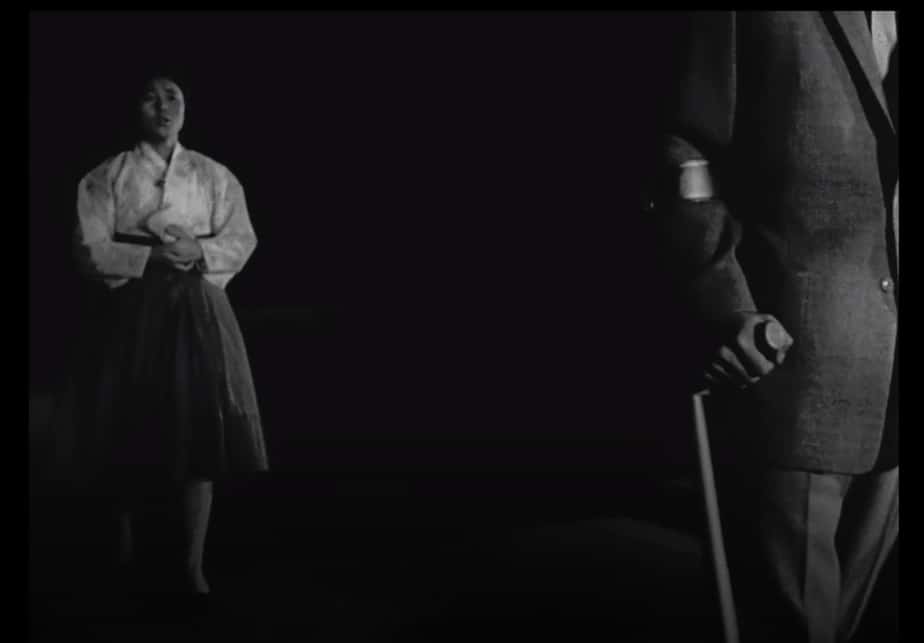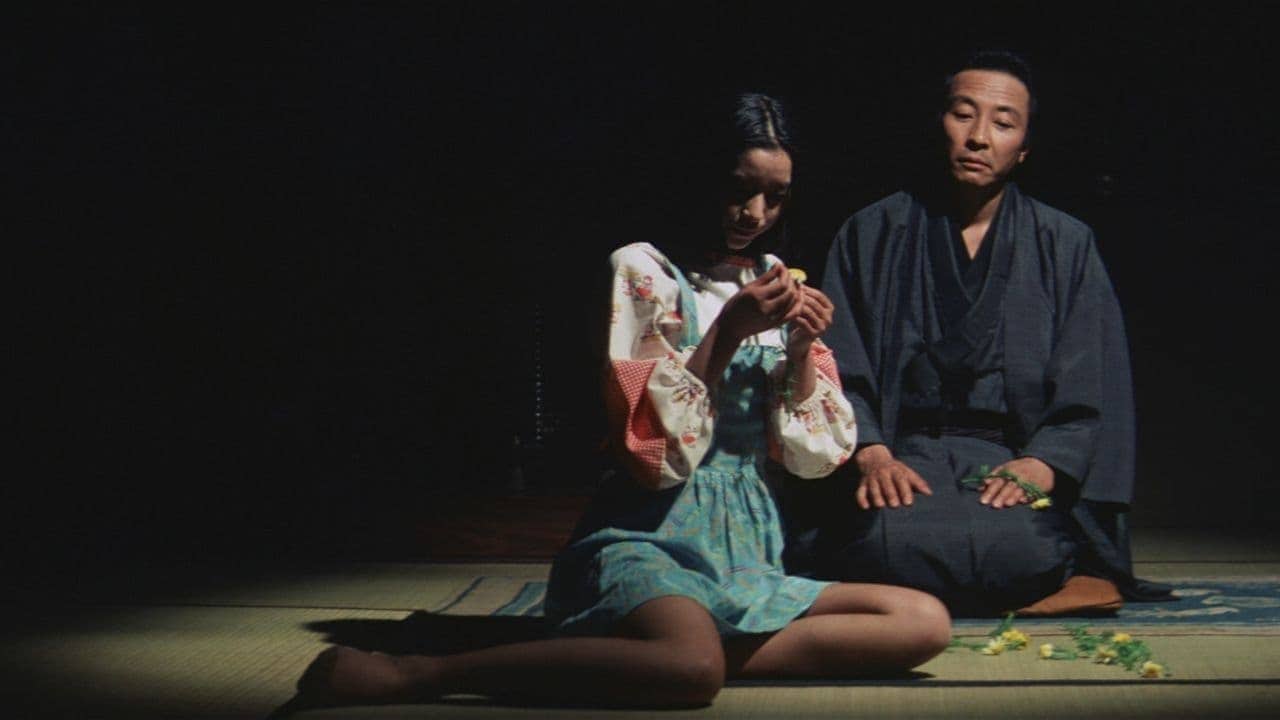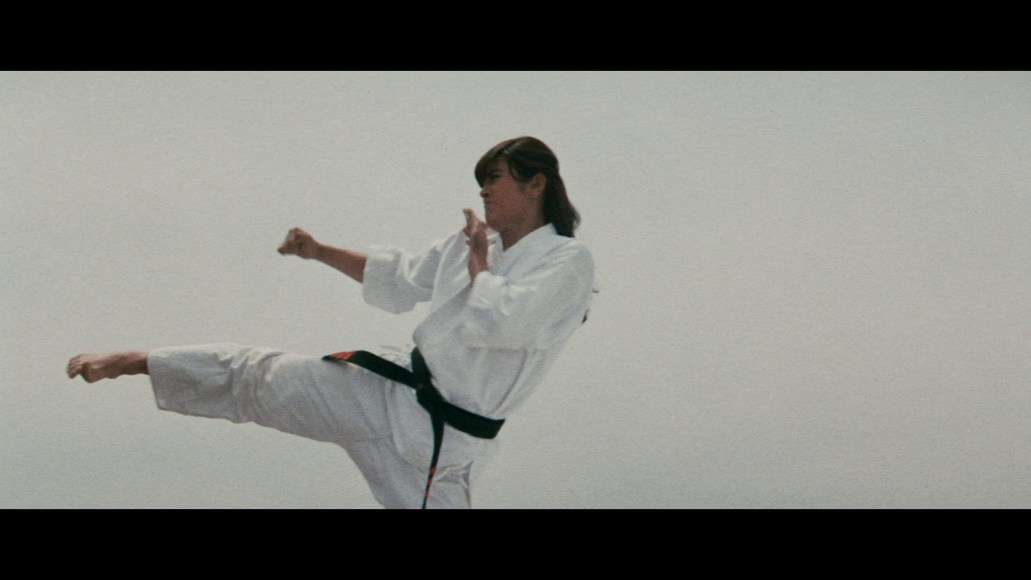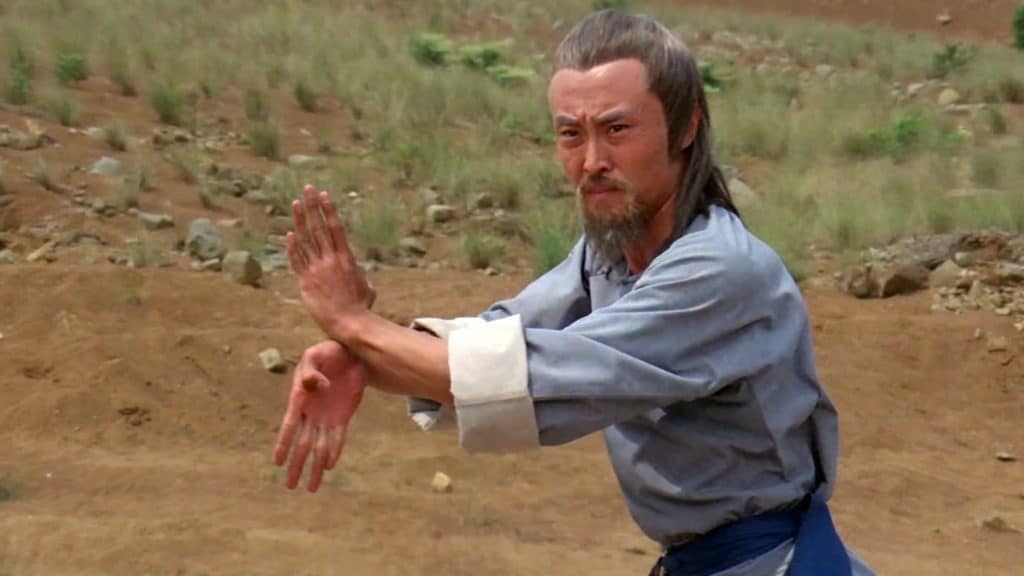22. Forever With You (Yu Hyun-mok, 1958)

The premises of the film follow all the norms of the melodrama, with the protagonists having to face a torrenting series of misfortunes, and very little good things happening throughout the story, as each plot twist actually worsens their situation.
Through this setting, however, Yu Hyun-mok manages to make a number of sociopolitical comments. The financial situation of the poor, who had no way out of their poverty during the time (after the Korean War that is), is the first and most obvious, at least partially justifying Gwang-pil's actions. The penetration of western culture in all parts of Korean society is another central one, with the music, drinks and way people dress as exemplified in the hostess club highlighting the fact as much as the way Christianity has changed Sang-moon. The third one, and somewhat more subtle, is presented through Ae-ran, who finds herself in the middle of the struggle of two men, without having any choice in the matter, although her feelings are quite clear from the beginning, as much as her faith in the constitution of marriage. The fact that she is bedridden for almost the whole duration of the main timeline also functions as a metaphor for her situation. On another note, the final revelation of the child's father also seems to refer to the divine justice both her and Gwang-pil seem to suffer due to having extra-marital relations, with the fact that she has the worse fate presenting another comment about the role of women in the then society. Do Kum-bong in the part highlights all the aforementioned elements quite fittingly.
23. The Money (Kim So-dong, 1958)

Kim So-dong directs this film in the familiar, extremely melodramatic style of many S. Korean films, where we watch the kind-hearted protagonist experiencing events that solely deteriorate his situation, without any sign of hope and with a growing sense of despair. The almost non-stop drama, the romance between Yeong-ho and Ok-kyeong, and the almost sadistic way fate unfolds for the protagonist, take care of the entertainment part of the narrative, which benefits the most by Kim Seung-ho-I's acting as Bong-soo, who gives a surprisingly measured but also quite nuanced performance that highlights both his good nature and his country-bumpkin naivety.
Contextually, however, Kim aims at highlighting a number of social issues, particularly regarding the despicability of capitalism and the way it takes advantage of the poor. Eok-jo and his wife, who are repeatedly portrayed as devilish, are the embodiment of this despicability, with the way they continue to cheat the naive, poor farmers stressing this fact in the most eloquent way.
24. The Love Marriage (Lee Byung-il, 1958)

Lee Byung-il directs a film mostly about the clash of traditional Korean values with Americanization, highlighting the hypocrisy of the previous generation, which is mirrored in Mrs. Ahn, about the concept. In that regard, Mrs. Ahn has no issues with her daughter marrying a man whose influences come from the US, or setting up her house in western style (including Greek-like ancient busts) but when the discussion goes towards the freedom girls enjoy in the US, and particularly regarding their disconnection from their parent's will, she simply closes her ears.
This attitude of hers, and the fact that Dr. Ko rarely takes a stand in the inevitable clash between mother and daughters, is the main source of the blights the girls experience in the main arc of the film, although each one's reaction is quite different. Moon-hi is devastated while Myeong-hi, amused. However, Lee does not make a point of showing that the daughters' way of thinking and actions are, necessarily, correct, and that of the parents, wrong, as exhibited by almost every individual story, at least until the rather forced happy ending takes over.
25. A College Woman's Confession (Shin Sang-ok, 1958)

Shin Sang-ok directs a film that is distinctly woman-centric, something that is evident from the first frame, when it is revealed that the only one who supported So-yeong was another woman, her grandmother. Furthermore, as the men that surround her and Hee-sook in the next scenes of the first part are portrayed as intensely despicable, Shin's comment regarding the nature of the two sexes becomes even more obvious. At the same time, the extremes So-yeong is forced to reach are justified through this concept, highlighting the fact that women can only survive by using their cunningness. These comments are depicted even more intensely by a secondary plot that unfolds in the second part of the movie, when So-yeong has become a lawyer and her first client is a woman who has suffered a similar, and occasionally even worse fate.
This secondary melodrama inside the main one is somewhat excessive, as forced sentimentalism eventually takes over the narrative, but as a plot ” trick “, it works quite nicely, adding entertainment through an element of agony regarding the outcome of the trial, and intensifying the overall comments about the place of women in the then Korean society. This part and the way it is placed inside the central story arc also highlights the excellent job done in the editing by Kim Yeong-hie, with this intervals being quite timely, not allowing So-yeong's happiness and success to be perceived as the norm of the era. His prowess also extends to the overall pace, which is fittingly fast.
26. The Bell Tower (Yang Ju-nam, 1958)

Yang Ju-nam's presentation of the narrative is quite interesting, since he manages to present a large part of the country's history, through the end of the Joseon era to the occupation years, through the life stories of the two protagonists. At the same time, the story of an obsession (to create the perfect bell) as a tool of presenting the reasons two people became cursed in life also works quite well, despite the obvious and somewhat excessive melodrama. Furthermore, through these two stories, Yang presents his subtle comments on Koreans' faith in the supernatural, Christianity, the war with Japan, comfort women, and the radical changes the country experienced in that time frame.
Apart from the aforementioned, however, the narrative is filled with confusion, since Yang does not seem sure about what he wanted to do with the story, ending up with a number of elements that lead the viewer to disorientation. For example, the story seems to imply that the two protagonists are father and daughter, but this concept never really materializes, leaving a number of unanswered questions, also regarding Yeong-sil's further fate and the impact her meeting with the man had on her. The fact that the same actress, Moon Jung-suk, plays all the women in Seok-seung's story also does not help in that regard, even if perceived as another comment about his obsession with the woman he initially made the promise too.
27. Even the Clouds are Drifting (Yu Hyun-mok, 1959)

Yu Hyun-mok uses a distinct melodramatic base, where everything that could go wrong for the members of the family actually does, in order though, to present a number of sociopolitical comments about Korea in the end of the 50s. The way the workers on strike treat Dong-seok both during the strike, and particularly after, when all the poor temps are laid off, seems like a pointy, anti-communist comment, particularly since the director of the factory eventually apologizes to the young man, justifying himself through his position and the permanent workers' actions. At the same time, the large differences between the lives of the poor and the rich also come to the fore, with the two friendly families highlighting the fact, although Yu actually presents the rich ones as benevolent benefactors of the poor and not as villains, as is usual the case.
The presentation of the two, radically different houses is where Park Seok-in's art direction finds its apogee, along with the various taverns the workers frequent, where Kim Hyung-keun's cinematography also shines. Talking about cinematography and overall composition of scene, the finale one, with the whole family next to the field is truly remarkable as both DP and director manage to present the plants waving in the wind in a fashion that makes them look as people cheering, in the most impressive scene of the film.
28. A Female Boss (Han Hyeong-mo, 1959)

The Hollywood aesthetics, as already mentioned, are everywhere to be found. The way the people dress, the music they listen to, even the way they conduct themselves occasionally speaking in English and having adopted western names all point towards this concept, as much as the scenes in night clubs where mambo and cha-cha seem to dominate, while the customers are drinking beer. Furthermore, a rather lengthy scene of a basketball game where Yong-ho proves the ” hero ” of his team and the rest of the office's crew cheer him could easily be found in any American movie. Lastly, the way women and particularly Yoanna conduct themselves, definitely points towards western society values regarding the emancipation of women.
However, gradually and somewhat cunningly, Han Hyeong-mo begins to undermine feminism, by having Yoanna getting into a pinch that only men can get her out of, with the solution to her problems coming as soon as she admits her limitations and feelings. Subsequently, through this approach, the aforementioned western values also share the same fate, since the ending of the film quite directly suggests that women are better suited staying at home and following Korean tradition, as indicated by the change of clothes Yoanna makes.
29. King Gojong and Martyr An Jung-Geun (Jeon Chang-keun, 1959)

The third part functions more as a noir/political thriller, as An Jung-geun and his comrades try to organize the resistance while avoiding the pro-Japanese police and the Occupation army. This part is rather agonizing and showcases both Jeon Chang-keun's direction and Lee Jong-gi's editing, whose combination results in a rather intriguing part, particularly during the assassination attempt.
The fourth part turns into a court drama, as we watch An Jung-geun challenging the court and protesting that he cannot be tried as a criminal since Ito Hirobumi and the Japanese Occupation Forces are the true criminals, to the growing annoyance of the judges. This part is where Jeon Chang-keun's excellent performance as An Jung-geun finds its apogee, just like the first part did the same for Kim Seung-ho-I's as King Gojong. The “last supper” which concludes the segment, gives a sense of calm melodrama, that works quite nicely in bringing down the tension that was building up to that point.
30. The Flower in Hell (Shin Sang-ok, 1958)

Shin Sang-ok directs a film that unfolds in two levels. The first and more evident one revolves around the erotic trio, and particularly Sonya, a genuine femme fatale who is willing to stop at nothing in order to achieve her goals. Her presentation benefits the most by Choi Eun-hee's performance, Shin's actual wife, who presents a woman who uses all the weapons in her arsenal (beauty, intelligence, confidence, and calculating nature) to make the people around her dance to her tunes. The way she seduces Dong-sik is probably the highlight of a great performance. In that fashion, Kim Hak as Yeong-sik and Jo Hae-won as Dong-sik play characters that eventually become her victims, despite their radically opposite nature, since the former is a disillusioned thief and the latter a “country-bumpkin” who knows very little of the capital's ways. Shing Sang-ok stresses this difference from the beginning of the film, which shows the elder brother stealing and the younger mugged. Both actors perform quite well in their respective parts, with the chemistry of the three being one of the production's best assets.
31. A Sister's Garden (Shin Sang-ok, 1959)

Shin Sang-ok presents a narrative that is filled with misery from the beginning, with the succession of events turning most of the protagonists, but mainly Jeong-hee, who is left in charge of taking care of herself and the siblings into tragic figures. Her feelings for Soon-cheol cannot be indulged, particularly because he is too timid to act upon his own, her sister does not seem to understand their situation at all, while her potential benefactor is revealed as something completely different, particularly since, eventually he asks her to marry him, essentially exploiting her complete lack of means. Soon-cheol is the second most tragic, since he is bound by his sense of obligation towards his mentor, and a rather harmful sense of dedication to him, while he soon realizes that the money he earns are not enough for his wishes. Even the little boy is presented as a tragic figure, particularly when he stumbles upon Myeong-hee about to have sex with Dong-soo, and is severely shocked by the spectacle.
The film follows the same, somewhat episodic, but consistently melodramatic form, only to shatter this approach with a kind of a happy ending, which seems, though, completely out of place, particularly due to the change of attitude by both Chairman Pang and Soon-cheol.













